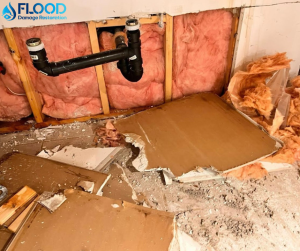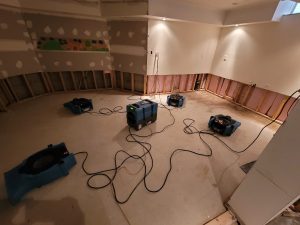Understanding the Threat: The Risks of Black Mold in Aurora
 Black mold, a fungus prevalent in homes, poses significant health risks, particularly in damp and warm environments where it finds the cellulose-based materials it thrives on, such as drywall or paper 1. This mold not only exacerbates asthma symptoms but also triggers allergic reactions through spores and microbial volatile organic compounds (VOCs), increasing health risks, especially for those with weakened immune systems. Its ability to grow and spread is facilitated by its simple requirements: moisture, oxygen, temperatures between 40 and 100 degrees Fahrenheit, and a food source.
Black mold, a fungus prevalent in homes, poses significant health risks, particularly in damp and warm environments where it finds the cellulose-based materials it thrives on, such as drywall or paper 1. This mold not only exacerbates asthma symptoms but also triggers allergic reactions through spores and microbial volatile organic compounds (VOCs), increasing health risks, especially for those with weakened immune systems. Its ability to grow and spread is facilitated by its simple requirements: moisture, oxygen, temperatures between 40 and 100 degrees Fahrenheit, and a food source.
Identifying and understanding the threat posed by black mold is crucial for homeowners in Aurora, as it can enter homes through several avenues, including windows, doors, vents, and even on clothing or pets 2. Awareness and early detection can lead to effective management, preventing the adverse health effects associated with exposure, such as sneezing, coughing, nasal congestion, red eyes, wheezing, shortness of breath, and dry cough, which can significantly impact quality of life.
The Science of Mold Growth Aurora
Mold, including varieties such as Cladosporium, Aspergillus, and Penicillium, is not just a single entity but a diverse group of fungi that can grow on many surfaces ranging from fabric to glass. These organisms thrive in moist, warm environments, colonizing various materials, including wood, paper, and plastic. They degrade these materials by digesting them, feeding on the substances they grow on.
The growth process of mold begins with tiny, microscopic spores that travel through the air and settle on wet surfaces or have high moisture content. In homes, these spores can be spread through HVAC systems, making them a pervasive threat as they can easily disseminate through different rooms 4. Black mold, or Stachybotrys chartarum, is a notorious mold that is particularly harmful due to its ability to produce mycotoxins. These mycotoxins can pose serious health risks when inhaled or come into contact with skin.
Black mold prefers warm and humid environments with little air circulation, and it often grows on materials rich in cellulose, such as wood, wallpaper, and ceiling tiles. Under optimal conditions, which include high humidity and warm temperatures, this type of mold can begin to develop within 24 to 48 hours. It is crucial to understand that mold spores are omnipresent; they can enter homes through doors, windows, or by attaching to clothing and pets. However, for growth to occur, moisture is a crucial factor.
Health Impacts of Mold Exposure Aurora
Mold exposure, particularly from black mold, poses significant health risks, affecting individuals differently based on their immune system strength and pre-existing health conditions. Respiratory and allergic reactions are among the most common ailments associated with mold exposure. For instance, individuals may experience worsened asthma symptoms, coughing, wheezing, and severe respiratory complications like hypersensitivity pneumonitis (HP), a condition characterized by lung inflammation due to immune sensitization to inhaled organic dust, presenting symptoms such as shortness of breath, cough, and fatigue.
Additionally, black mold exposure can lead to allergic reactions manifesting as sneezing, red eyes, skin rashes, and sinus inflammation. These symptoms significantly impair daily activities and overall quality of life. For those with weakened immune systems, the risks escalate, potentially leading to fungal infections that are difficult to manage.
The toxic effects of black mold are primarily associated with the mycotoxins it produces. While these toxins are more commonly linked with ingestion through contaminated food, inhaling mycotoxins from mold growth on damp surfaces can also cause health issues. These include severe respiratory infections, toxic reactions, and, in extreme cases, effects as grave as brain damage and psychiatric issues. It is crucial for residents, particularly in moisture-prone areas, to be vigilant about mold growth to mitigate these health risks.
Identifying Mold in Your Home Aurora
Initial Signs and Symptoms
Identifying the presence of black mold in your home starts with recognizing the initial signs and symptoms. Homeowners should be alert to the appearance of dark-colored spots on walls or a persistent musty smell, which often indicates the onset of mold growth 10. These signs are frequently accompanied by physical symptoms in residents, such as nasal congestion or coughing triggered by mold exposure
Visual Identification and Smell Aurora
Black mold can be visually identified by its distinctive color and texture. It appears dark green, brown, or black and has a wet, slimy surface 8. Often, it forms clusters of circular spots that may exhibit fuzzy white edges, making it stand out from other types of mold. Additionally, a strong, musty smell, often described as earthy and akin to rotting vegetation, is a telltale sign of black mold presence in the home.
Professional Assessment and Testing Aurora
Due to the health risks of black mold and its ability to grow in hidden places, professional assessment is crucial. Homeowners can use air pump kits to test for mold spores or hire professionals to conduct thorough inspections, especially in areas prone to moisture and water damage. Signs such as peeling wallpaper, warped drywall, or mold on shower grout also necessitate professional evaluation.
Common Causes of Mold Buildup Aurora
Persistent humidity in regions close to large bodies of water often increases mold growth in homes. This mold typically accumulates on walls, ceilings, and less visible places like dark closets and kitchen sinks. Ensuring proper ventilation is essential to mitigate this moisture build-up
Leakages within the home, such as pipes and roofs, significantly contribute to mold issues. Homeowners should regularly inspect areas behind drywall and under sinks for any signs of leaking pipes, as these moist environments foster mold growth . Similarly, a damaged roof can allow water to seep into attics or ceiling spaces, creating ideal conditions for mold to thrive. Regular checks for roof integrity and immediate repairs are crucial to prevent mold proliferation.
Poorly ventilated spaces and items retaining dampness, like wet clothing, also promote mold growth. Rooms with stagnant air can accumulate moisture, which molds find hospitable. It is important to ventilate each room adequately to discourage mold development. Additionally, wet clothing should be hung to dry immediately during warmer months to prevent mold formation.
Preventive Measures Against Mold Aurora
Moisture Control and Ventilation
- Maintain Indoor Humidity: Keeping indoor humidity levels between 30% and 50% is crucial to inhibit mold growth. Use dehumidifiers or air conditioners to manage humidity, especially during humid months.
- Enhance Airflow: Utilize exhaust fans in high moisture areas like kitchens and bathrooms to improve ventilation. Ensuring that clothes dryers vent outside and using fans or opening windows when cooking or showering can significantly reduce moisture accumulation.
- Immediate Leak Repairs: Address leaks in roofs, walls, or plumbing within 48 hours to prevent mold from taking hold. Regular inspections for water damage and prompt repair can prevent long-term mold issues.
Material Choices and Housekeeping Aurora
- Mold-resistant Materials: Opt for mold-resistant products such as paints and building materials when repairing or renovating, especially in moisture-prone areas.
- Avoid Carpets in Damp Areas: Carpets can trap moisture and foster mold growth. Avoid installing carpets in bathrooms, basements, and other moisture-prone areas.
- Regular Cleaning: Use mold-killing products in bathrooms and regularly clean gutters and downspouts to prevent water buildup near the home. These practices help maintain a mold-resistant environment.
Professional and Proactive Measures Aurora
- Professional Mold Assessment: If mold presence is suspected, especially black mold, hiring a professional for assessment and removal is advisable. This prevents the spread of mold spores during removal.
- Addressing Root Causes: After removing mold, it’s essential to tackle the underlying moisture issues that allowed mold to grow initially. This may involve improving home insulation, fixing leaks, and ensuring proper drainage around the property.
- Regular Humidity Checks: Use hygrometers to monitor indoor humidity regularly. This allows for timely adjustments to moisture control methods, keeping the indoor environment unfavorable for mold growth.
Professional Mold Remediation Aurora
The approach to tackling mold in your home varies depending on the severity of the infestation. For mild cases, homeowners can manage the situation by using a mixture of bleach and water or white vinegar to scrub the affected surfaces while wearing protective equipment. However, if the mold covers more than 10 square feet, the U.S. Environmental Protection Agency (EPA) advises seeking professional assistance.
Professional mold remediation services are crucial when dealing with extensive mold problems, especially those hidden within walls, ceilings, or under carpeting. These areas often harbor more mold than is visible, requiring specialized techniques for complete removal. Professionals use a combination of manual scraping and the application of organic and inorganic cleaning agents to safely remove mold. This approach not only addresses the visible mold but also targets the spores, minimizing the risk of recurrence.
For homeowners, choosing professional remediation means ensuring that the underlying moisture issues contributing to the mold growth are identified and resolved. This comprehensive approach helps prevent future infestations, safeguarding the home’s structural integrity and the health of its residents. Moreover, professional services are equipped to handle mold safely, reducing the risk of cross-contamination and exposure to potentially toxic spores.
Conclusion
Having explored the multifaceted threats posed by black mold in homes, the importance of awareness, preventative measures, and proper remediation cannot be overstated. The health implications of mold exposure, ranging from mild allergic reactions to severe respiratory conditions, underscore the critical need for homeowners to adopt proactive strategies in identifying and combating mold growth. By maintaining a vigilant approach to moisture control, employing strategic ventilation, and opting for mold-resistant materials, residents can significantly mitigate the risks associated with mold infestation.
When mold presence becomes evident, professional intervention becomes paramount, especially in severe instances where the health of inhabitants could be at risk. Professional assessment and remediation go beyond surface cleaning, addressing the root cause of mold growth and ensuring long-term prevention. Ultimately, the safety and well-being of residents lie in the balance of timely detection, effective management, and the adoption of preventive measures against mold buildup in homes.
FAQs
1. Is it safe to stay in a home with black mold present in Aurora?
It is generally unsafe to remain in a home infested with black mold due to its potential health risks. If unavoidable, it’s important to isolate and seal off areas where the mold is concentrated to minimize exposure.
2. What health problems can arise from residing in a home with black mold in Aurora?
Living in a home with black mold can lead to various health issues, including nasal congestion, sneezing, coughing, wheezing, respiratory infections, and exacerbation of asthma and allergies. People who are sensitive or allergic might also experience a runny or blocked nose, eye and skin irritation, and additional wheezing.
3. What are the common symptoms of mold toxicity to be aware of?
The ten warning signs of mold toxicity include cognitive difficulties such as brain fog, anxiety, and memory problems; persistent fatigue; frequent headaches and migraines; skin irritations; respiratory complications; digestive issues; joint pain and muscle aches; and mood fluctuations.
4. How dangerous is exposure to black mold in Aurora?
While black mold is often associated with negative health impacts, no conclusive evidence links it to severe health issues. Mold thrives in moist, humid conditions and poorly ventilated spaces, increasing the risk of growth and exposure in such environments.



